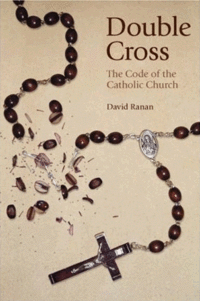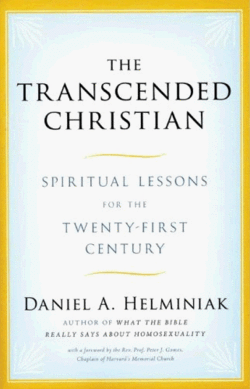 Roman Catholicism:
Roman Catholicism:
The Wrong Way and the Right Way
Double Cross: The Code of the Catholic Church
By David Ranan
Theo Press, pb,
426 pages, $25.95
The Transcended Christian:
Spiritual Lessons for the 21st Century
By Daniel A. Helminiak
Alyson Books, pb, 315 pages, $16.95
Reviewed by Toby Johnson
On a flight to Easton Mountain Retreat Center in upstate New York for a gathering of “leaders” in Gay spirituality, I read David Ranan’s scathing report on the history and organizational structure of the Catholic Church in regard to power and politics. As disturbing as the book was, it was interesting reading and held my attention even through all the distractions of air travel.
Ranan is surprisingly evenhanded and low-key in reporting on a history of unbelievable abuse of power, corruption and hypocrisy (especially regarding sexual ethics). In almost every case he calmly presents the facts and explains that the various abuses seem to come from organizational imperatives and maintenance concerns rather than from flaws in doctrine. At times you wonder how he can keep cataloguing all these apparent crimes against humanity without ever quite calling for the abolition of the institution and the damnation of all its layers of minions.
The book begins with an explanation of the structure of the Church and particularly the Vatican authority. He explains the origins of the church, the notion of miracles as evidence for authority, and the place of sin—and the sacramental power to forgive sin—as a tool of social control. The next chapters report on the Inquisition, the Index of Forbidden Books, and, specifically, the case against Galileo in the 17th century at the beginning of the development of the scientific method and observation as the source of truth (rather than religious authority or revelation).
Poor Galileo, the prelates showed the seventy-year-old man the instruments of torture they’d use to question him and scared him into recanting facts he’d seen with his own eyes about the movement of the heavenly bodies. All because Psalm 104 says: “The earth is firmly fixed; it shall not be moved.” Even a cursory reading of the verses in context can see the Psalmist was praising the wonder of God’s creation, not describing astrophysical dynamics! Yet for that verse, the advance of Western science was delayed centuries. Of course, in the end, the Church lost. And in due course the pope forgave Galileo. Though the pope to do so was John Paul II, in our own lifetimes—a little late. And even then, JP II didn’t admit the Church was wrong, only that Galileo turned out to have been right about the astronomy.
The next chapters deal with the corruption of popes, religious violence, anti-Semitism (and the Holocaust). Some of the medieval popes amassed huge fortunes that some passed on to their illegitimate offspring, all the while calling the faithful to obey the rules about avoiding sexual pleasure and giving generously to the Church. The list of popes with offspring just goes on and on. Popes apparently don’t have “children”; they have “nephews.” By the 20th century these kinds of abuses had disappeared, but there was still a Vatican banking scandal around the time of the election of John Paul II. (Lucien Gregoire’s Gay consciousness-sourced book Murder in the Vatican, reviewed previously in White Crane #67, gave the banking scandal even more sinister overtones.)
Then there’s the chapter on sexual morality and the Church’s intransigence with regard to issues like the dignity of women, divorce, homosexuality, contraception and family planning, even condom use to prevent the spread of AIDS. At every point, Ranan shows, the Church opted to ignore human suffering and up-to-date solutions to age-old problems and to insist instead on reiterating its errors from the past in order to assert that it had never made any mistakes. A classic example Ranan cites is telling women whose husbands are HIV+ that they should trust in God’s will for their health since they are not permitted to use condoms to prevent their infection.
And finally there’s a long discussion of the sexual abuse scandal that has surfaced in the last decades. Ranan focuses mainly on the cover-up, rather than the supposed evils of pedophilia itself, since that is the institutionally generated criminality. The catalogue is long.
The conclusion the book reaches, a little equivocally, is that maybe the Church needs dismantling, but that “matters of faith such as virgin birth or transubstantiation” are not necessarily threatened by this critique of the institutional structure.
I personally would go a bit further. Bringing a Buddhistic perspective to the question of the Catholic Church and its elaborate system of doctrines, I’d say the bad behavior Double Cross documents is empirical proof—like that Galileo saw with his own eyes—that there is no God, at least the way the Church teaches, and that that God has no power over human affairs and does not answer prayers. That’s a bold and difficult assertion (though thoroughly and reverently Buddhist). But some huge number of the prayers that go up daily from Catholics is for the guidance of Church leaders. It is abundantly clear they aren’t getting any divine guidance. The behavior of the Church doesn’t seem to reflect any awareness at all of the teachings of Jesus about love trumping rules.
Double Cross: The Code of the Catholic Church certainly challenged my affection and nostalgia for the religion of my youth. It was much more readable and compelling than I’d expected. It’s well written and it is pretty convincing.
The final paragraph sums up the argument that Gay people, in particular, should take to heart: “Faithful Catholic liberals hope and believe that change can be effected within the Church. They hope for reform. Such reform, however, is unlikely to suffice. The shape-up which is necessary is beyond the scope of a reform.”
 Gay spiritual writer, theologian, psychologist, scholar Daniel Helminiak offers another way to think of the Catholic Church. Helminiak was for many years a Dignity priest. He still speaks to Catholic—and non-Catholic—groups around the country about the real meaning of Christian and Catholic religion. His book What the Bible Really Says About Homosexuality is one of the perennial bestsellers in the Gay genre, addressing a central question religious homosexuals have to ask themselves in the process of coming out.
Gay spiritual writer, theologian, psychologist, scholar Daniel Helminiak offers another way to think of the Catholic Church. Helminiak was for many years a Dignity priest. He still speaks to Catholic—and non-Catholic—groups around the country about the real meaning of Christian and Catholic religion. His book What the Bible Really Says About Homosexuality is one of the perennial bestsellers in the Gay genre, addressing a central question religious homosexuals have to ask themselves in the process of coming out.
Helminiak has far surpassed traditional Catholic religiousness, yet without dissing the tradition. His most important insight (and that is an important word in a discussion of his thought because it is the name of the major book by Helminiak’s great intellectual influence, the 20th C. Canadian Jesuit theologian Bernard Lonergan, author of Insight: A Study of Human Understanding) is that “spirituality” is about human consciousness and personality and only tangentially about “God.” Indeed, you don’t need a concept of “God” to be spiritual, and your accomplishment at being “spiritual” will be to understand what God really is. This is religion in service of the human spirit, not the human in the service of institutional power structures.
Not only is Daniel Helminiak an astute thinker and an accomplished writer, he is also a wonderful and interesting teacher and, from his history as a priest, a marvelous preacher. His most recent book, The Transcended Christian: Spiritual Lessons for the Twenty-First Century, is, in fact, based on sermons he gave during his Dignity years that were preserved by members of his flock because they were so impactful. Now these sermon notes have been updated and rewritten into eighteen interesting and sometimes entertaining essays that demonstrate the right way to think about Catholic teaching and tradition. Readers of Helminiak’s serious theological works will find this book just as intelligent, but also as readable and personable as it is intelligent. There’s a sweetness to his voice that reveals the pastoral origins of the texts.
Let me proudly report that Daniel credits me with the inspiration for his title. Years ago when I was the Gay therapist and a community spokesperson in San Antonio and he was the Dignity priest, we had a delightful conversation about the evolution of religion. Coming out of my Campbellian/comparative religions vision of “the new myth” as the understanding of religious imagery and myth from outside and over and above — in which all myths are true insofar as it’s possible to rise to a higher perspective and transcend the conflicting details, I called Daniel, with his post-mythical, post-institutional spirituality, a “transcended Catholic.”
Each chapter of the book begins with a Scripture text. The commentaries then offer insightful ways of understanding what the texts can really mean to us two thousand years later. This isn’t religion looking back at a fantasized past to give it validity, but rather the familiar symbols and metaphors of religion applied to our lives today to give our lives validity — and that’s especially so, of course, of our Gay lives.
To offer but one example, in the essay on Christmas and Jesus as a prophet revealing a new kind of attitude about God (based in love of others, not obedience to taboos), Helminiak offers recognition of Gay identity as an experience of such “a revelation from God”: “In the depths of our own soul, we experience a dawning, a realization. We grasp an intuition, and from it we form a new message, we configure a new vision. It comes from the source of all goodness. It emerges out of the Life Force that is working in and through us all. Our vision or message points toward a more wholesome life for everybody. Isn’t this what ‘revelation from God’ is about?” Helminiak ties in the Christmas story with the image of John the Baptist, the prophet who calls for the transformation of society, as opposed to the popular character of modern Christmas, Santa Claus. Santa Claus represents the mythological, fairytale side of the story that just reconfirms conventional assumptions, while John the Baptist represents the transcended vision.
Over and over again in the book, Helminiak gives a Queer twist to usual stories. And I mean the double entendre. He offers new and unexpected ways to understand the familiar stories, and he interprets them to offer positive and inclusive meaning for us Queer Gay people.
This is a book I’ve been reading slowly, one chapter at a time, relishing the twists.
Just as David Ranan’s book about the Church makes one question the usefulness and validity of Catholic tradition, so Daniel Helminiak’s redeems the tradition by showing how transcending it is, in fact, doing it right, doing it the way Jesus would have intended.
This is just an excerpt from this issue of White Crane. We are a reader-supported journaland need you to subscribe to keep this conversation going. So to read more from this wonderful issue SUBSCRIBE to White Crane. Thanks!
Toby Johnson is the author and editor of countless fine books like Gay Spirituality, and Charmed Lives. He is also former publisher of White Crane Journal and currently Reviews editor. He lives in San Antonio Texas. Visit him at www.tobyjohnson.com